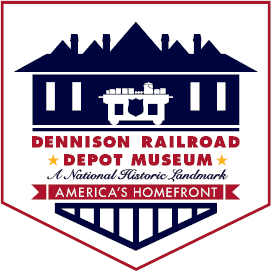How We Came to Be
The small village of Dennison, Ohio lies halfway between Columbus, OH and Pittsburgh, PA, exactly 100 miles to the east and west of these major cities. This location was not a coincidence, but specifically chosen because a steam engine only went 100 miles before it had to take on coal and water and change crews. Thus, Dennison is a true railroad town in every sense – it was founded in 1864 as a water stop for the railroad.
Dennison, Ohio became one of the most complete railroad shops and yards in the country at the turn of the 20th Century, boasting 40 acres of railroad shops, 21 passenger trains a day, 21 freight trains a day and 3,000 railroad employees. Dennison was on the most direct route from New York City to St. Louis. The Village became a freight and passenger terminal and the headquarters for the Panhandle Division of the Pennsylvania Railroad.
What began in 1855 as the Steubenville and Indiana Railroad, was transformed into the Pittsburgh, Cincinnati and St. Louis Railway in 1868. Eventually consolidated into the Pennsylvania Railroad, the nation’s standard railroad, at the turn-of the century, the Dennison yards experienced a golden era until hit hard by a strike in 1921. Despite resurgence during wartime, the yards never recovered. As shops closed, the yards experienced a steady decline.
The development of affordable cars and highways had a devastating impact on the train industry. In 1968, Penn Central controlled the line and saw the last passenger train stop at the Depot in the 1970s. The yards were phased out, and Conrail was at the helm in 1976. In the early 1980s, the line was downgraded and freight was rerouted to other Conrail lines.
Saving the Depot
In a landmark decision, the FCC stopped Conrail from tearing all the tracks out. The State of Ohio purchased the tracks, and in 1992, the Ohio Central Railroad Systems became operators of the line, renaming it the Columbus & Ohio River Railroad. Since that time, tourist train excursions have operated on the line, and attention has focused on rebuilding the freight business.
The Dennison Depot, built in 1873 and listed on the National Register of Historic Places, stands as a proud symbol of Dennison’s vast railroad heritage. Purchased by the Village of Dennison from Conrail in 1984, the Depot was originally restored by a strong grassroots volunteer group and local vocational school students. It reopened in 1989 in memory of the many railroad employees, servicemen and women, and travelers who passed through its doors.
From 1992 to 2007, the Depot has undergone four additional phases of restoration. Preservation efforts focused on brick, sandstone, chimneys and water drainage. All architectural elements – brackets, eaves, sunbursts, dormer and stained glass windows were restored and rebuilt. Original signs were reproduced and rehung, and much needed amenities such as restrooms, office space, handicap ramps and a beautiful Victorian era safety fence were added to the platform.
Wartime History
Although Dennison was the site of a WWI Red Cross Canteen, it is perhaps most famous for its role during WWII. These yards were located on a railway which provided a key link to the Strategic Corridor for National Defense going east-west. This trunk line played a vital role in the disbursement of troops during WWII, making the strong welded rail heavily traveled and the likely location for a serviceman’s Canteen. For soldiers being shipped out west for training, or east for departure over seas, the Depot was a common traveling point.
The Dennison Depot Servicemen’s Canteen operated from March 19, 1942 to April 8, 1946. A million and a half G.I.s were served free food, coffee and smiles by 3,987 volunteers from eight counties at the Dennison Depot Salvation Army Servicemen’s Canteen. The Canteen operated around the clock, 24 hours a day, 7 days a week, providing a great boost to the home front effort and earning the town the nickname “Dreamsville, USA”.
Today, that hometown hospitality continues to welcome travelers to the only remaining railroad building left in the original 40 acre yards – the Depot. The Depot, built in 1873, was saved from demolition in 1984, restored by a strong grassroots community effort, and is today a symbol of pride and heritage. In 1989, the Dennison Railroad Depot Museum opened to the public.
The Depot Today
The Depot now houses a Museum, Restaurant and Gift Shop. Open year round, it offers a full calendar of exhibits, special events and family programs. The Whistle Stop Gift Shop, the museum gift store, is an excellent source for railroad gifts, WWII Memorabilia and Americana.
The Museum features exhibits within the Depot’s Women’s Waiting Room, the Baggage Room and the Railway Express Agency building built in 1921. Children will love using their binoculars and watching the trains in the Model Train Room. The History of the Railroad Yards and Dennison’s Golden Era are highlighted in various exhibits. Be sure to take the kids on “Bing’s Scavenger Hunt” throughout the building to find Bing.
In March of 2007, a new wing opened at the Museum. The wing is composed of five railroad coaches attached to the building. They include: The Children’s Interactive Railroad Experience Car, the Archival Research Library, our rare WWII Hospital Car, a special Feature Exhibit Car, and a Local History Car. The Keystone Theater was also opened to the public.
Outside, be sure to climb through the caboose and explore the Museum’s collection of Rolling Stock. Picnic facilities are available on the platform. Explore our neighbors on the Historic Center Street District, Tuscarawas County’s very first paved road and now a historic district.
